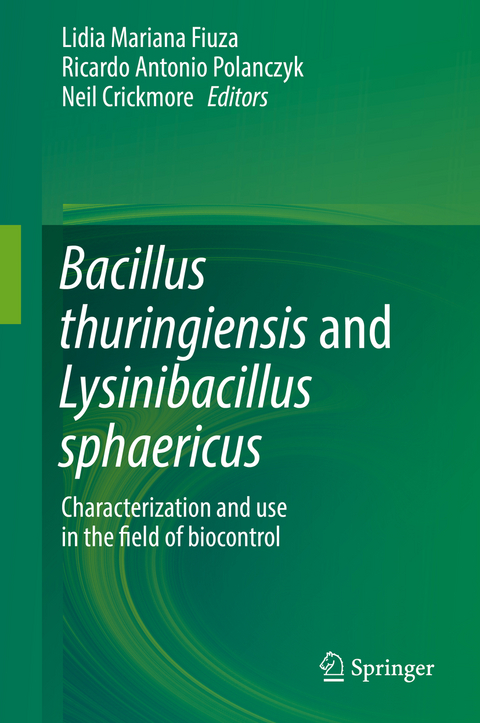
Bacillus thuringiensis and Lysinibacillus sphaericus
Springer International Publishing (Verlag)
978-3-319-56677-1 (ISBN)
This volume presents a comprehensive perspective of the biopesticides Bacillus thuringiensis and Lysinibacillus sphaericus, from their basic biology to agriculture, forestry and public-health applications. It covers their ecology, virulence factors, and genetic characterization. The topics related to agriculture and forestry include mode of action, receptors of insect pests, and heterologous expression of toxins in insect cells and plants. Public-health researchers will find information on vector control programs with an emphasis on the Neotropical region. The book also discusses new products and the global market.
Dr. Lidia Mariana Fiuza – PhD (ENSAM-Montpellier/France), is currently Researcher at Instituto Riograndense do Arroz (IRGA) and member of the Agricultural Sciences Commitee at Research Foundation of Rio Grande do Sul, Brazil. She specializes in the areas of toxicology, microbiology, and entomology, with an emphasis in bacteriology and acting on the following topics: Bacillus thuringiensis and correlates; genes cry; insecticidal proteins; plants-Bt; toxin interactions; microbial control of pests and diseases. As innovation and technology activities, she is a partner in the Control_Agro_Bio Pesquisa e Defesa Agropecuária Ltda., which is currently accredited in the Brazilian Ministry of Agriculture as a Collaborating Center for Pest Risk Analysis – ARP, Section of Agricultural Defense, Department of Plant Protection.Dr. Ricardo Antonio Polanczyk – PhD (ESALQ/USP), is currently Assistant Professor at UNESP. Before this, he was at UFES, working with Dr. Pratissoli in IPM systems. Microbial control of agricultural pests is his main field of research, including the interactions between microbial control agents and pesticides and Bt plants. In 2014 he took part in the course "Risk Analysis: Role of Science in GMO Decision-making" in the International Centre for Genetic Engineering and Biotechnology (Trieste- Italy).Dr. Neil Crickmore – PhD (University of Warwick), is currently Senior Lecturer in Molecular Genetics, University of Sussex and Adjunct Professor State Key Laboratory for the Biology of Plant Diseases and Insect Pests, Institute of Plant Protection, Chinese Academy of Agricultural Sciences, Beijing, China. Before, he was Research Associate at University of Cambridge. Widely heralded today as a leading figure in Bacillus thuringiensis research. Chair and webmaster of International Bacillus thuringiensis toxin nomenclature committee; Convenor of the Bacterial Division of the IOBC/WPRS.
Chapter 1 - Bacillus thuringiensis characterization: morphology, physiology, biochemistry, pathotype, cellular and molecular aspects.- Chapter 2 - The biology, ecology and taxonomy of Bacillus thuringiensis and related bacteria.- Chapter 3 - Bacillus thuringiensis toxin classification.- Chapter 4 - Insecticidal proteins from Bacillus thuringiensis and their mechanism of action.- Chapter 5 - Effect of Bacillus thuringiensis on parasitoids and predators.- Chapter 6 - Characterization of Bacillus thuringiensis using plasmid patterns, AFLP and rep-PCR.- Chapter 7 - New sequencing technologies and genomic analysis applied to Bacillus thuringiensis.- Chapter 8 - Expression of Bacillus thuringiensis in insect cells.- Chapter 9 - Bacillus thuringiensis: different targets and interactions.- Chapter 10 - Specificity and cross-order activity of Bacillus thuringiensis pesticidal proteins.- Chapter 11 - American Bacillus thuringiensis based biopesticides market.- Chapter 12 - Mass production, application, and market development of Bacillus thuringiensis biopesticides in China.- Chapter 13 - The role of Embrapa in the development of tools to control biological pests: a case of success.- Chapter 14 - Bacillus entomopathogenic based biopesticides in vector control programs in Brazil.- Chapter 15 - Resistance of mosquitoes to entomopathogenic bacteria based larvicides: current status and strategies for management.- Chapter 16 - The importance of Bacillus thuringiensis in the context of genetically modified plants in Brazil.- Chapter 17 - Resistance of Spodoptera frugiperda to Bacillus thuringiensis proteins in in the Western Hemisphere.
| Erscheinungsdatum | 02.07.2017 |
|---|---|
| Zusatzinfo | VIII, 288 p. 32 illus., 15 illus. in color. |
| Verlagsort | Cham |
| Sprache | englisch |
| Maße | 155 x 235 mm |
| Gewicht | 608 g |
| Themenwelt | Medizin / Pharmazie ► Medizinische Fachgebiete ► Pharmakologie / Pharmakotherapie |
| Naturwissenschaften ► Biologie ► Botanik | |
| Naturwissenschaften ► Biologie ► Mikrobiologie / Immunologie | |
| Technik ► Umwelttechnik / Biotechnologie | |
| Weitere Fachgebiete ► Land- / Forstwirtschaft / Fischerei | |
| Schlagworte | agricultural science • Agriculture • applied microbiology • Biomedical and Life Sciences • Biotechnology • Botany & plant sciences • Botany & plant sciences • Entomology • Environmental Engineering/Biotechnology • environmental science, engineering & technology • Environmental science, engineering & technology • Life sciences: general issues • Microbiology • Microbiology (non-medical) • Molecular Biology • pharmacology • Pharmacology/Toxicology • Plant sciences • Toxicology |
| ISBN-10 | 3-319-56677-6 / 3319566776 |
| ISBN-13 | 978-3-319-56677-1 / 9783319566771 |
| Zustand | Neuware |
| Haben Sie eine Frage zum Produkt? |
aus dem Bereich


